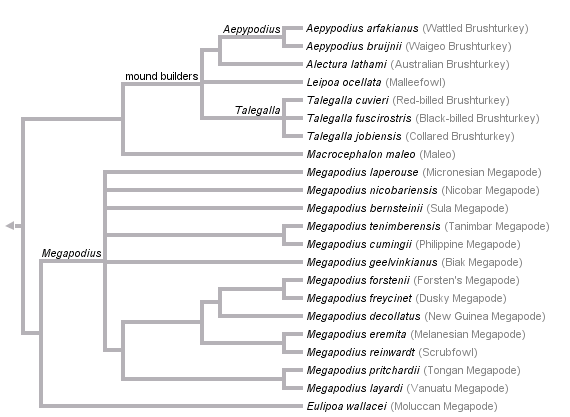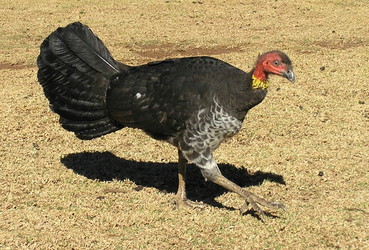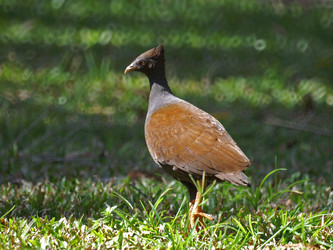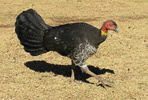Megapodiidae
Megapodes
Joseph W. Brown


This tree diagram shows the relationships between several groups of organisms.
The root of the current tree connects the organisms featured in this tree to their containing group and the rest of the Tree of Life. The basal branching point in the tree represents the ancestor of the other groups in the tree. This ancestor diversified over time into several descendent subgroups, which are represented as internal nodes and terminal taxa to the right.

You can click on the root to travel down the Tree of Life all the way to the root of all Life, and you can click on the names of descendent subgroups to travel up the Tree of Life all the way to individual species.
For more information on ToL tree formatting, please see Interpreting the Tree or Classification. To learn more about phylogenetic trees, please visit our Phylogenetic Biology pages.
close boxSummary tree based on nuclear and mitochondrial DNA sequence data (Birks and Edwards, 2002). This tree is consistent with a morphological character-based reconstruction (Jones et al., 1995) except for the placement of the root (within the mound builders for the latter). A. bruijnii, four species of Megapodius (M. bernsteinii, M. laperouse, M. nicobariensis, and M. geelvinkianus) and two species of Talegalla (T. cuvieri and T. jobiensis) were not included in these analyses.
References
Birks, S. M., and S. V. Edwards. 2002. A phylogeny of the megapodes (Aves: Megapodiidae) based on nuclear and mitochondrial DNA sequences. Molecular Phylogenetics and Evolution 23: 408-421.
Clark, G. A. 1964. Life histories and the evolution of megapodes. Living Bird 3: 149-167.
Frith, H. J. 1956. Breeding habits of the family Megapodiidae. Ibis 98: 620-640.
Gill, F. and M. Wright. 2006. Birds of the World: Recommended English Names. Princeton NJ: Princeton University Press.
Jones, D., and S. Birks. 1992. Megapodes: recent ideas on origins, adaptations and reproduction. Trends in Ecology and Evolution 7: 88-91.
Jones, D. N., R. W. R. J. Dekker, and C. S. Roselaar. 1995. The Megapodes. Oxford University Press, Oxford.
Title Illustrations

| Location | Lamington National Park, Queensland, Australia |
|---|---|
| Specimen Condition | Live Specimen |
| Source | Australian Brush-Turkey |
| Source Collection | Flickr |
| Image Use |
 This media file is licensed under the Creative Commons Attribution-NonCommercial License - Version 2.0. This media file is licensed under the Creative Commons Attribution-NonCommercial License - Version 2.0.
|
| Copyright | © 2005 Pierre Pouliquin |
| Scientific Name | Megapodius reinwardt castanotus |
|---|---|
| Location | Cairns, QLD, Australia |
| Specimen Condition | Live Specimen |
| Source | Orange-footed Scrubfowl (Megapodius reinwardt) |
| Source Collection | Flickr |
| Image Use |
 This media file is licensed under the Creative Commons Attribution-NonCommercial License - Version 2.0. This media file is licensed under the Creative Commons Attribution-NonCommercial License - Version 2.0.
|
| Copyright | © 2006 David Cook |
About This Page
Joseph W. Brown

University of Michigan Museum of Zoology, Ann Arbor, Michigan, USA
Correspondence regarding this page should be directed to Joseph W. Brown at
Page copyright © 2005 Joseph W. Brown
 Page: Tree of Life
Megapodiidae. Megapodes.
Authored by
Joseph W. Brown.
The TEXT of this page is licensed under the
Creative Commons Attribution-NonCommercial License - Version 3.0. Note that images and other media
featured on this page are each governed by their own license, and they may or may not be available
for reuse. Click on an image or a media link to access the media data window, which provides the
relevant licensing information. For the general terms and conditions of ToL material reuse and
redistribution, please see the Tree of Life Copyright
Policies.
Page: Tree of Life
Megapodiidae. Megapodes.
Authored by
Joseph W. Brown.
The TEXT of this page is licensed under the
Creative Commons Attribution-NonCommercial License - Version 3.0. Note that images and other media
featured on this page are each governed by their own license, and they may or may not be available
for reuse. Click on an image or a media link to access the media data window, which provides the
relevant licensing information. For the general terms and conditions of ToL material reuse and
redistribution, please see the Tree of Life Copyright
Policies.
- First online 20 December 2005
Citing this page:
Brown, Joseph W. 2005. Megapodiidae. Megapodes. Version 20 December 2005 (temporary). http://tolweb.org/Megapodiidae/26297/2005.12.20 in The Tree of Life Web Project, http://tolweb.org/









 Go to quick links
Go to quick search
Go to navigation for this section of the ToL site
Go to detailed links for the ToL site
Go to quick links
Go to quick search
Go to navigation for this section of the ToL site
Go to detailed links for the ToL site